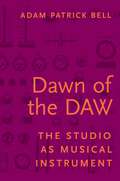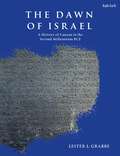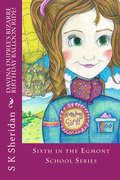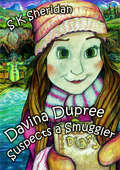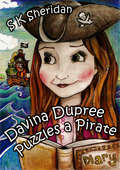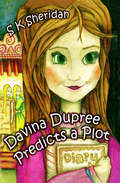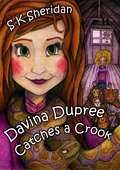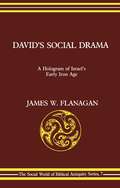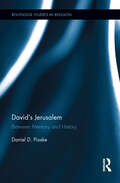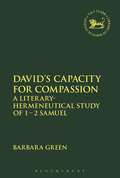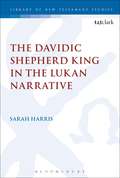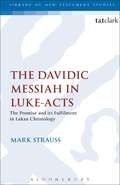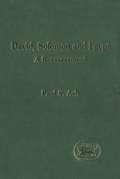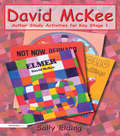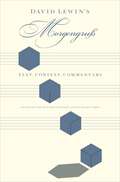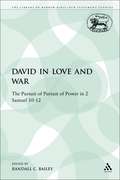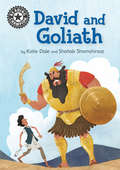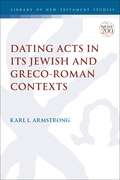- Table View
- List View
DAWN OF THE DAW C: The Studio as Musical Instrument
by Adam Patrick BellDawn ot the DAW tells the story of how the dividing line between the traditional roles of musicians and recording studio personnel (producers, recording engineers, mixing engineers, technicians, etc.) has eroded throughout the latter half of the twentieth century to the present. Whereas those equally adept in music and technology such as Raymond Scott and Les Paul were exceptions to their eras, the millennial music maker is ensconced in a world in which the symbiosis of music and technology is commonplace. As audio production skills such as recording, editing, and mixing are increasingly co-opted by musicians teaching themselves in their do-it-yourself (DIY) recording studios, conventions of how music production is taught and practiced are remixed to reflect this reality. Dawn of the DAW first examines DIY recording practices within the context of recording history from the late nineteenth century to the present. Second, Dawn of the DAW discusses the concept of "the studio as musical instrument" and the role of the producer, detailing how these constructs have evolved throughout the history of recorded music in tandem. Third, Dawn of the DAW details current practices of DIY recording--how recording technologies are incorporated into music making, and how they are learned by DIY studio users in the musically--chic borough of Brooklyn. Finally, Dawn of the DAW examines the broader trends heard throughout, summarizing the different models of learning and approaches to music making. Dawn of the DAW concludes by discussing the ramifications of these new directions for the field of music education.
Dawn of the DAW: The Studio as Musical Instrument
by Adam Patrick BellDawn ot the DAW tells the story of how the dividing line between the traditional roles of musicians and recording studio personnel (producers, recording engineers, mixing engineers, technicians, etc.) has eroded throughout the latter half of the twentieth century to the present. Whereas those equally adept in music and technology such as Raymond Scott and Les Paul were exceptions to their eras, the millennial music maker is ensconced in a world in which the symbiosis of music and technology is commonplace. As audio production skills such as recording, editing, and mixing are increasingly co-opted by musicians teaching themselves in their do-it-yourself (DIY) recording studios, conventions of how music production is taught and practiced are remixed to reflect this reality. Dawn of the DAW first examines DIY recording practices within the context of recording history from the late nineteenth century to the present. Second, Dawn of the DAW discusses the concept of "the studio as musical instrument" and the role of the producer, detailing how these constructs have evolved throughout the history of recorded music in tandem. Third, Dawn of the DAW details current practices of DIY recording--how recording technologies are incorporated into music making, and how they are learned by DIY studio users in the musically--chic borough of Brooklyn. Finally, Dawn of the DAW examines the broader trends heard throughout, summarizing the different models of learning and approaches to music making. Dawn of the DAW concludes by discussing the ramifications of these new directions for the field of music education.
The Dawn of Israel: A History of Canaan in the Second Millennium BCE
by Lester L. GrabbeIn this companion volume to his bestselling Ancient Israel: What Do We Know and How Do We Know It? Lester L. Grabbe provides the background history of the main ancient Near Eastern peoples and empires: Babylonia, Assyria, Urartu, Hittites, Amorites, Egyptians. Grabbe's focus is on Palestine/Canaan and covers the early second millennium, including the Middle Bronze Age and the Second Intermediate Period and Hyksos rule of Egypt. Grabbe also addresses the question of a 'patriarchal period'. The main focus of the book is on the second half of the second millennium: Late Bronze and early Iron Age, the Egyptian New Kingdom, the Amarna letters, the Sea Peoples, the question of 'the exodus', the early settlements in the hill country of Palestine, and the first mention of Israel in the Merenptah inscription. Archaeology and the contribution of the social sciences both feature heavily, as does inscriptional and iconographic material. As such this volume provides a fascinating portrayal of ancient Israel and this definitive work by one of the world's leading biblical historians will be of interest to all students and scholars of biblical history.
The Dawn of Israel: A History of Canaan in the Second Millennium BCE
by Lester L. GrabbeIn this companion volume to his bestselling Ancient Israel: What Do We Know and How Do We Know It? Lester L. Grabbe provides the background history of the main ancient Near Eastern peoples and empires: Babylonia, Assyria, Urartu, Hittites, Amorites, Egyptians. Grabbe's focus is on Palestine/Canaan and covers the early second millennium, including the Middle Bronze Age and the Second Intermediate Period and Hyksos rule of Egypt. Grabbe also addresses the question of a 'patriarchal period'. The main focus of the book is on the second half of the second millennium: Late Bronze and early Iron Age, the Egyptian New Kingdom, the Amarna letters, the Sea Peoples, the question of 'the exodus', the early settlements in the hill country of Palestine, and the first mention of Israel in the Merenptah inscription. Archaeology and the contribution of the social sciences both feature heavily, as does inscriptional and iconographic material. As such this volume provides a fascinating portrayal of ancient Israel and this definitive work by one of the world's leading biblical historians will be of interest to all students and scholars of biblical history.
Davina Dupree's Bizarre Birthday Balloon Ride: 6th in Egmont School Series (Egmont School Series #6)
by SK SheridanIt's Davina Dupree's birthday, and her mysterious parents have bought her and best friend Arabella a luxury hot air balloon ride. At first Davina enjoys the ride, but when parts of the balloon start breaking down, Davina suspects foul play is involved. Will she and Arabella be able to pin point the culprit and stop the vandalism before the balloon starts to fall?
Davina Dupree Suspects a Smuggler: Fourth In The Egmont School Series
by S. K. SheridanFourth in the Egmont School Series: Davina Dupree and her best friend Arabella enjoy their day out down an old smuggling tunnel that leads from their boarding school's cellars to a nearby beach. On returning to school they discover a crisis has occurred - someone has stolen all of Marcel the Chef's expensive ingredients! Arabella may never be able to eat her favourite pudding, Magic Mousse, ever again! Davina and Arabella resolve to solve the mystery, a decision that plunges them into a murky world of smuggling and intrigue. The question is, will they be able to rescue the ingredients in time, or will the smuggler get the better of them?
Davina Dupree Puzzles a Pirate: Third in the Egmont School Series
by S. K. SheridanThird in the Egmont School Series: Davina Dupree sets off on an exciting, luxury school trip with the rest of the first years from Egmond Exclusive Boarding School. At first everything goes well, as the girls settle into tents on Ni Island and study the rare animal and plant species there. But it's not long before a pirate ship is spotted on the horizon and expensive items go missing from several girls' tents. Will Davina and her best friend Arabella be able to outwit the pesky pirates before the school trip is ruined?
Davina Dupree Predicts a Plot: Second in the Egmont School Series
by S.K. SheridanSecond in the Egmont School Series: Davina Dupree is excited to be back in her luxury boarding school after the half term holidays, especially as famous Hollywood director Alfie Calpone will soon be arriving to direct the school play. But when jewellery goes missing from First Years' dorms, bullies Cleo and Clarice attempt to pin the blame on Davina's new friend Lottie. The clock starts ticking as Davina attempts to unearth the real culprit before the curtain goes up on opening night... If you enjoy reading Malory Towers by Enid Blyton, you'll love this book. Davina is a modern day Darrell Rivers and her school, Egmont Exclusive School for Girls, is the ultimate, modern day boarding school, full of thrilling adventure, mouth watering food and bags of mysterious goings on... A perfect read for children who enjoy school fiction, adventure, mystery or humorous stories
Davina Dupree Catches a Crook: 5th in Egmont School Series (Egmont School Series #5)
by SK SheridanThe pupils at Egmont Exclusive Boarding School for Girls are thrown into a frenzy of delight when famous explorer Dr Aardvark arrives to teach geography. But it's not long before Davina Dupree and her best friend Arabella notice there's something rather odd about Dr Aardvark and his menagerie of animals. However, the sudden collapse of beloved headmistress, Mrs Fairchild, quickly redirects their attention. Can Davina and Arabella get to the bottom of the mysterious goings on before anything else awful happens?
David's Social Drama: A Hologram of Israel's Early Iron Age (The Library of Hebrew Bible/Old Testament Studies)
by James W. FlanaganTaking an interdisciplinary approach, Flanagan deals with methodological issues in his discussion of not just Davidic studies but also the whole area of what he terms 'social world studies' - his label for social scientific analyses of ancient Israel. Also addressed in this book are the traditions of biblical history as well as archeological and literary information and how it pertains to David.
David's Jerusalem: Between Memory and History (Routledge Studies in Religion)
by Daniel PioskeThe history of David’s Jerusalem remains one of the most contentious topics of the ancient world. This study engages with debates about the nature of this location by examining the most recent archaeological data from the site and by exploring the relationship of these remains to claims made about David’s royal center in biblical narrative. Daniel Pioske provides a detailed reconstruction of the landscape and lifeways of early 10th century BCE Jerusalem, connected in biblical tradition to the figure of David. He further explores how late Iron Age (the Book of Samuel-Kings) and late Persian/early Hellenistic (the Book of Chronicles) Hebrew literary cultures remembered David’s Jerusalem within their texts, and how the remains and ruins of this site influenced the memories of those later inhabitants who depicted David’s Jerusalem within the biblical narrative. By drawing on both archaeological data and biblical writings, Pioske calls attention to the breaks and ruptures between a remembered past and a historical one, and invites the reader to understand David’s Jerusalem as more than a physical location, but also as a place of memory.
David's Jerusalem: Between Memory and History (Routledge Studies in Religion)
by Daniel PioskeThe history of David’s Jerusalem remains one of the most contentious topics of the ancient world. This study engages with debates about the nature of this location by examining the most recent archaeological data from the site and by exploring the relationship of these remains to claims made about David’s royal center in biblical narrative. Daniel Pioske provides a detailed reconstruction of the landscape and lifeways of early 10th century BCE Jerusalem, connected in biblical tradition to the figure of David. He further explores how late Iron Age (the Book of Samuel-Kings) and late Persian/early Hellenistic (the Book of Chronicles) Hebrew literary cultures remembered David’s Jerusalem within their texts, and how the remains and ruins of this site influenced the memories of those later inhabitants who depicted David’s Jerusalem within the biblical narrative. By drawing on both archaeological data and biblical writings, Pioske calls attention to the breaks and ruptures between a remembered past and a historical one, and invites the reader to understand David’s Jerusalem as more than a physical location, but also as a place of memory.
David's Capacity for Compassion: A Literary-Hermeneutical Study of 1 - 2 Samuel (The Library of Hebrew Bible/Old Testament Studies #641)
by Barbara GreenIn this book Barbara Green demonstrates how David is shown and can be read as emerging from a young naive, whose early successes grow into a tendency for actions of contempt and arrogance, of blindness and even cruelty, particularly in matters of cult. However, Green also shows that over time David moves closer to the demeanor and actions of wise compassion, more closely aligned with God.Leaving aside questions of historicity as basically undecidable Green's focus in her approach to the material is on contemporary literature. Green reads the David story in order, applying seven specific tools which she names, describes and exemplifies as she interprets the text. She also uses relevant hermeneutical theory, specifically a bridge between general hermeneutics and the specific challenges of the individual (and socially located) reader. As a result, Green argues that characters in the David narrative can proffer occasions for insight, wisdom, and compassion. Acknowledging the unlikelihood that characters like David and his peers, steeped in patriarchy and power, can be shown to learn and extend wise compassion, Green is careful to make explicit her reading strategies and offer space for dialogue and disagreement.
The Davidic Shepherd King in the Lukan Narrative (The Library of New Testament Studies #558)
by Sarah HarrisIn Luke-Acts, Jesus can be seen to take on the attributes of the Davidic shepherd king, a representation successfully conveyed through specific narrative devices. The presence of the shepherds in the birth narrative can be understood as an indication of this understanding of Jesus. Sarah Harris analyses the multiple ways scholars have viewed the shepherds as characters in the narrative, and uses this as an example of how the theme of Jesus' shepherd nature is interwoven into the narrative as a whole.From the starting point of Jesus' human life, Harris moves to later events portrayed in Jesus' ministry in which he is seen to enact his message as God's faithful Davidic shepherd, in particular, the parable of the Lost Sheep and the Zacchaeus pericope (19:1-10). Harris uses this latter encounter to underline that Jesus may be hailed as a King by the crowds as he enters Jerusalem, but he is not simply a king. He is God's Davidic Shepherd King, as prophesied in Micah 5 and Ezekiel 34, who brings the gospel of peace and salvation to the earth.
The Davidic Shepherd King in the Lukan Narrative (The Library of New Testament Studies)
by Sarah HarrisIn Luke-Acts, Jesus can be seen to take on the attributes of the Davidic shepherd king, a representation successfully conveyed through specific narrative devices. The presence of the shepherds in the birth narrative can be understood as an indication of this understanding of Jesus. Sarah Harris analyses the multiple ways scholars have viewed the shepherds as characters in the narrative, and uses this as an example of how the theme of Jesus' shepherd nature is interwoven into the narrative as a whole.From the starting point of Jesus' human life, Harris moves to later events portrayed in Jesus' ministry in which he is seen to enact his message as God's faithful Davidic shepherd, in particular, the parable of the Lost Sheep and the Zacchaeus pericope (19:1-10). Harris uses this latter encounter to underline that Jesus may be hailed as a King by the crowds as he enters Jerusalem, but he is not simply a king. He is God's Davidic Shepherd King, as prophesied in Micah 5 and Ezekiel 34, who brings the gospel of peace and salvation to the earth.
The Davidic Messiah in Luke-Acts: The Promise and its Fulfilment in Lukan Christology (The Library of New Testament Studies #110)
by Mark StraussThe nature of Lukan christology has been much debated in recent years, with scholars claiming the pre-eminence of such categories as Lord, Prophet, Christ, or Isaianic Servant. In the present work the author examines one major theme within Luke's christology, that of the coming king from the line of David. A study of the Lukan birth narrative and the speeches in Acts reveals that Luke shows a strong interest in this royal-messianic theme, introducing it into passages which are introductory and programmatic for his christology as a sermon, portraying Jesus in strongly prophetic terms. The author seeks a synthesis of these seemingly conflicting royal and prophetic portraits in Luke's interpretation of the Old Testament book of Isaiah. When Isaiah is read as a unity, the eschatological deliverer is at the same time Davidic king (Isa. 9.11), suffering servant of Yahweh (Isa. 42-53), and prophet herald of salvation (Isa. 61), leading God's people on an eschatological new exodus. On the basis of this synthesis the christology of Luke-Acts is seen to be both consistent and unified, forming an integral part of Luke's wider purpose in his two-volume work.
David, Solomon and Egypt: A Reassessment (The Library of Hebrew Bible/Old Testament Studies)
by Paul S. AshAsh re-examines the question of the relationship between Egypt and Palestine during the time of David and Solomon. By analysing all the available evidence-epigraphical sources from Egypt, archaeological data from Palestine and the pertinent biblical texts-he concludes that relations and contacts between Egypt and the peoples inhabiting ancient Palestine at the time of David and Solomon were minimal. Any reconstructions of the history of relations and contacts between Egypt and Palestine, including ancient Israel, must take this study into consideration.
David McKee: Author Study Activities for Key Stage 1 (A Health Care for Women International Publication)
by Sally EldingThis innovative series is designed to help primary teachers plan focused sessions on the work of popular, well-loved and valued authors, both classic and contemporary. Each book contains a range of activities for use directly in the classroom, covering biographical information about the author; a review of the author's work and a summary of major themes in his/her key texts; key language features of the author; frameworks to help children analyze, evaluate and compare texts, and to develop personal opinions of authors' works; ideas for writing modeled on or developed from key texts; speaking and listening opportunities; drama and role play ideas; and references to video, CD-ROM, websites and ICT activities. Inside each book is a full-color pullout poster illustrating the work of the author, which also has a set of challenges for children on the back. David McKee is an author and illustrator, creator of Mr Benn, King Rollo, and the ever-popular patchwork elephant, Elmer. Building on children's enjoyment of the characters and their adventures, this book presents activities that focus on narrative structure, character development, settings and themes. Most importantly, the activities are designed to make learning about stories as much fun as reading them. Games and activities include: fortunately/unfortunately and chain of events - exploring cause and effect; comparing plots - using a matrix to order information; looking for clues about Elmer - building a character sketch; mapping feelings - exploring character development; time talk and Isabel's diary - understanding setting, sequence and relationships between the two; making a story map - recognizing picture and context clues; comparing the video to the written text; and text detective work using extracts.
David McKee: Author Study Activities for Key Stage 1 (A Health Care for Women International Publication)
by Sally EldingThis innovative series is designed to help primary teachers plan focused sessions on the work of popular, well-loved and valued authors, both classic and contemporary. Each book contains a range of activities for use directly in the classroom, covering biographical information about the author; a review of the author's work and a summary of major themes in his/her key texts; key language features of the author; frameworks to help children analyze, evaluate and compare texts, and to develop personal opinions of authors' works; ideas for writing modeled on or developed from key texts; speaking and listening opportunities; drama and role play ideas; and references to video, CD-ROM, websites and ICT activities. Inside each book is a full-color pullout poster illustrating the work of the author, which also has a set of challenges for children on the back. David McKee is an author and illustrator, creator of Mr Benn, King Rollo, and the ever-popular patchwork elephant, Elmer. Building on children's enjoyment of the characters and their adventures, this book presents activities that focus on narrative structure, character development, settings and themes. Most importantly, the activities are designed to make learning about stories as much fun as reading them. Games and activities include: fortunately/unfortunately and chain of events - exploring cause and effect; comparing plots - using a matrix to order information; looking for clues about Elmer - building a character sketch; mapping feelings - exploring character development; time talk and Isabel's diary - understanding setting, sequence and relationships between the two; making a story map - recognizing picture and context clues; comparing the video to the written text; and text detective work using extracts.
David Lewin's Morgengruß: Text, Context, Commentary
by David Bard-Schwarz Richard CohnArguably one of the most influential and revered figures in contemporary music theory, David Lewin (1933-2003) revolutionized the field through his work on transformational theory and theoretical methodology. David Lewin's Morgengruß: Text, Context, Commentary presents in print for the first time Lewin's legendary 1974 essay on Franz Schubert's "Morgengruß," from the composer's song cycle, Die Schöne Müllerin. The essay was central to Lewin's graduate teaching, and copies of it have circulated by hand through the music-scholarly community for decades. This book presents the original text of Lewin's essay along with over 200 graphical illustrations. Lewin's ability to present an artful and rich argument, based on a close reading of a short, "simple" score is but one of the wonders to behold in his masterful essay. At once deeply nuanced and widely accessible, Lewin's "Morgengruß" offers insight into Schubert's composition as well as the analytical process itself. Along with the full text of Lewin's essay, this book includes a small but pointed collection of essays interpreting the content and significance of Lewin's "Morgengruß." Drawing on current research as well as personal reflection, editors Richard Cohn and David Bard-Schwarz, along with contributors Brian Kane and Henry Klumpenhouwer, elaborate on the analytical, pedagogical, and philosophical contexts of Lewin's work. Taken together, the editors and contributors offer a compelling account of the enduring significance of Lewin's writing. David Lewin's Morgengruß is a must-have for anyone with an interest in Lewin's career, Schubert's music, or music theory generally.
David Lewin's Morgengruß: Text, Context, Commentary
by David Bard-Schwarz and Richard CohnArguably one of the most influential and revered figures in contemporary music theory, David Lewin (1933-2003) revolutionized the field through his work on transformational theory and theoretical methodology. David Lewin's Morgengruß: Text, Context, Commentary presents in print for the first time Lewin's legendary 1974 essay on Franz Schubert's "Morgengruß," from the composer's song cycle, Die Schöne Müllerin. The essay was central to Lewin's graduate teaching, and copies of it have circulated by hand through the music-scholarly community for decades. This book presents the original text of Lewin's essay along with over 200 graphical illustrations. Lewin's ability to present an artful and rich argument, based on a close reading of a short, "simple" score is but one of the wonders to behold in his masterful essay. At once deeply nuanced and widely accessible, Lewin's "Morgengruß" offers insight into Schubert's composition as well as the analytical process itself. Along with the full text of Lewin's essay, this book includes a small but pointed collection of essays interpreting the content and significance of Lewin's "Morgengruß." Drawing on current research as well as personal reflection, editors Richard Cohn and David Bard-Schwarz, along with contributors Brian Kane and Henry Klumpenhouwer, elaborate on the analytical, pedagogical, and philosophical contexts of Lewin's work. Taken together, the editors and contributors offer a compelling account of the enduring significance of Lewin's writing. David Lewin's Morgengruß is a must-have for anyone with an interest in Lewin's career, Schubert's music, or music theory generally.
David in Love and War: The Pursuit of Pursuit of Power in 2 Samuel 10-12 (The Library of Hebrew Bible/Old Testament Studies)
by Randall C. BaileyDavid in Love and War is a reworking of the dissertation that Bailey worked on while at Emory College in Atlanta, Georgia. His interests in literary critical concerns directed him in regards to the information he wanted to cover in his book. Bailey covers 2 Samuel 10 –12 as well as the connection between David and Bathsheba.
David and Goliath: Independent Reading 11 (Reading Champion #511)
by Katie DaleAn exciting retelling of the famous story of David, a young shepherd boy, who faces the mighty giant warrior, Goliath, armed only with a slingshot and pebble.Reading Champion offers independent reading books for children to practise and reinforce their developing reading skills.Fantastic, original stories are accompanied by engaging artwork and a reading activity. Each book has been carefully graded so that it can be matched to a child's reading ability, encouraging reading for pleasure.Independent Reading 11 stories are the perfect introduction to first chapter books for children aged 6+ who are reading at book band 11 in classroom reading lessons.The Key Stage 2 Reading Champion Books are suggested for use as follows:Independent Reading 11: start of Year 3 or age 7+Independent Reading 12: end of Year 3 or age 7+Independent Reading 13: start of Year 4 or age 8+Independent Reading 14: end of Year 4 or age 8+Independent Reading 15: start of Year 5 or age 9+Independent Reading 16: end of Year 5 or age 9+Independent Reading 17: start of Year 6 or age 10+Independent Reading 18: end of Year 6 or age 10+
Dating Acts in its Jewish and Greco-Roman Contexts (The Library of New Testament Studies)
by Karl Leslie ArmstrongThere has been consistent apathy in recent years with regard to the long-standing debate surrounding the date of Acts. While the so-called majority of scholars over the past century have been lulled into thinking that Acts was written between 70 and 90 CE, the vast majority of recent scholarship is unanimously adamant that this middle-range date is a convenient, political compromise. Karl Armstrong argues that a large part of the problem relates to a remarkable neglect of historical, textual, and source-critical matters. Compounding the problem further are the methodological flaws among the approaches to the middle and late date of Acts.Armstrong thus demonstrates that a historiographical approach to the debate offers a strong framework for evaluating primary and secondary sources relating to the book of Acts. By using a historiographical approach, along with the support of modern principles of textual criticism and linguistics, the historical context of Acts is determined to be concurrent with a date of 62–63 CE.
Dating Acts in its Jewish and Greco-Roman Contexts (The Library of New Testament Studies)
by Karl Leslie ArmstrongThere has been consistent apathy in recent years with regard to the long-standing debate surrounding the date of Acts. While the so-called majority of scholars over the past century have been lulled into thinking that Acts was written between 70 and 90 CE, the vast majority of recent scholarship is unanimously adamant that this middle-range date is a convenient, political compromise. Karl Armstrong argues that a large part of the problem relates to a remarkable neglect of historical, textual, and source-critical matters. Compounding the problem further are the methodological flaws among the approaches to the middle and late date of Acts.Armstrong thus demonstrates that a historiographical approach to the debate offers a strong framework for evaluating primary and secondary sources relating to the book of Acts. By using a historiographical approach, along with the support of modern principles of textual criticism and linguistics, the historical context of Acts is determined to be concurrent with a date of 62–63 CE.
